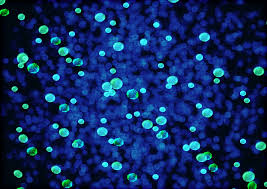Some people in hospital die not from the illness or accident that got them admitted but from germs they catch once there. In the United States alone, there are hundreds of thousands of hospital-acquired infections each year, leading to tens of thousands of deaths. Seeking to lower this toll, researchers have now come up with an immune-boosting cocktail that increases the survival of mice exposed to the microbes responsible.
The three-compound formulation, which the researchers unusually refer to as a vaccine, provided up to 28 days of protection from the notorious hospital bacterium Pseudomonas aeruginosa, among others, and seems to work by enhancing the innate immune system—the body’s first-line, generalized response to invading pathogens. “It’s a very interesting approach,” says Jay Kolls, a pulmonologist and vaccine researcher at Tulane University. “This is one of the first papers I’ve seen where people are trying to target [these infections] using multiple components that activate the innate immune system.”
However, he and other researchers note vaccines typically refer to products that use a microbe or bits of it to trigger specific, long-lasting immunity to one or several related pathogens. This new product, which uses nonspecific ingredients to provide short-term protection against diverse bacteria and fungi, is better called an “immune stimulant” or “enhancer,” they say.
The immunity-enhancing formula, described today in Science Translational Medicine, was discovered by mistake as researchers tried to develop a traditional vaccine for antibiotic-thwarting bacteria known as methicillin-resistant Staphylococcus aureus (MRSA). Brad Spellberg, an infectious diseases researcher at Los Angeles General Medical Center, and colleagues had combined proteins from this microbe with three immune-stimulating compounds, or adjuvants, thought to enhance vaccine effectiveness: a chemical compound called aluminum hydroxide, whole glucan particles from fungal cell walls, and monophosphoryl lipid A, an ingredient of bacterial cell membranes.
The resulting cocktail increased survival times in mice whose blood was subsequently infected with MRSA—but, unexpectedly, so did the control formulation containing just the adjuvants. “The [MRSA] proteins were completely irrelevant,” Spellberg says. “We started asking, ‘Could it work against other organisms at well?’”
Testing the adjuvants against other bacteria and tweaking the recipe as they went, the researchers landed on another combo—aluminum hydroxide, monophosphoryl lipid A, and a fungal compound called mannan—that provided even better protection and worked against more hospital-associated microbes.
Collaborating with University of Southern California Ph.D. student Jun Yan and colleagues at AstraZeneca and other institutions, Spellberg found the formula limited blood infections by drug-resistant bacteria such as carbapenem-resistant Klebsiella pneumoniae, one of the leading causes of bloodstream infections, as well as fungi such as Candida albicans. It worked against lung infections, too, such as those caused by carbapenem-resistant P. aeruginosa, a particularly common cause of disease in patients with cystic fibrosis.
Although most untreated mice died within days of catching these germs, mice receiving the adjuvants survived up to several weeks. Repeating the experiment using a small number of rodents engineered to have human rather than mouse immune cells showed the formulation still boosted survival, suggesting the approach could work in people, too.
The effect wasn’t long-lasting: A month after immunization, differences in survival rates between treated and untreated mice disappeared. However, this short protection duration wouldn’t be a big disadvantage if the results carry over into humans, Kolls notes, as most patients spend only a few weeks in the hospital at a time.
Several additional experiments suggested the mice’s innate immune system was key to the cocktail’s protective effect. Mice engineered to lack mature B and T cells, components of the adaptive immune system that orchestrate pathogen-specific responses, were still protected by the adjuvant combo, the researchers found. Rodents lacking functional macrophages, sentinel cells that engulf pathogens and are required for the innate immune response, fared much worse.
Spellberg draws a parallel between this study’s findings and other groups’ work on so-called “off-target” effects of the Bacillus Calmette–Guérin (BCG) vaccine, which was developed for tuberculosis (TB) and contains weakened bacteria. Although the BCG vaccine induces protection against TB-causing microbes in the standard way, via the adaptive immune system, research suggests it also provides bonus protection against certain respiratory viruses, among other germs, likely by enhancing innate immunity.
The team’s data certainly support a central role for innate immunity, says Isabelle Bekeredjian-Ding, a vaccine researcher at the Paul Ehrlich Institute, “but there are still some questions open” about the precise mechanism. For example, the researchers showed the cocktail triggers changes in gene activity in macrophages, but it’s not clear how they lead to protection against infection. She adds that a lack of mechanism doesn’t necessarily present an obstacle to evaluating the formula in clinical trials, however.
Jalees Rehman, a cell biologist at the University of Illinois College of Medicine says future work should first check whether the adjuvant combo could trigger dangerous inflammation in patients, particularly among those prone to autoimmune disease. Early signs are reassuring—analyses of signaling molecules called cytokines in the blood of treated mice pointed to an anti-inflammatory state overall—but studies of other tissues and animals prone to autoimmune-like disease will be needed to be sure.
He also wonders which patients might benefit most from the novel approach. “Do you [give this to] every person who enters the hospital? Do you have to be assured that they don’t have a preexisting infection?” Spellberg, who is named as a co-inventor on patents related to the findings, says he and his colleagues are already investigating this question as they seek research partners to move the work into clinical trials. Preliminary data suggest the formulation doesn’t worsen existing infections, he adds, “but that’s science that needs to be nailed down.”







